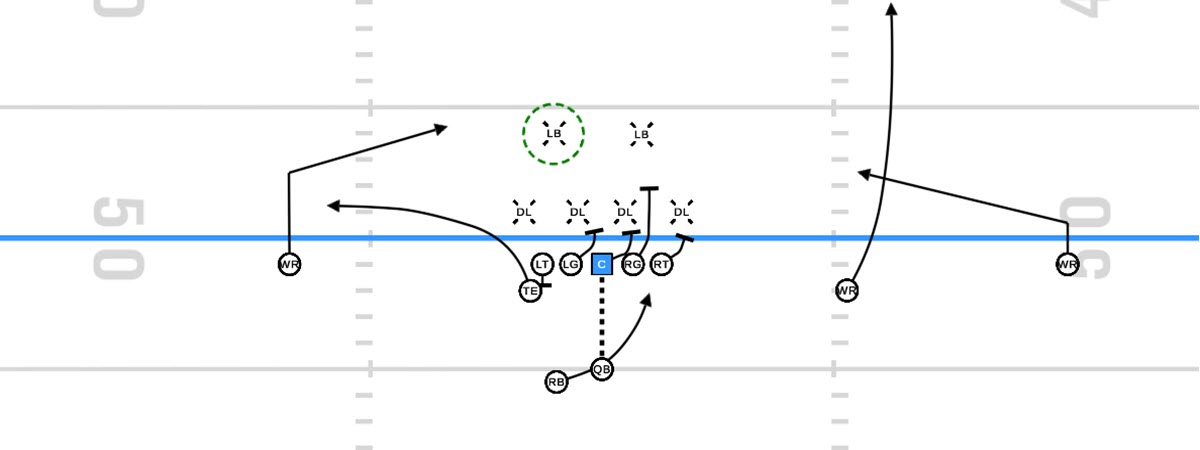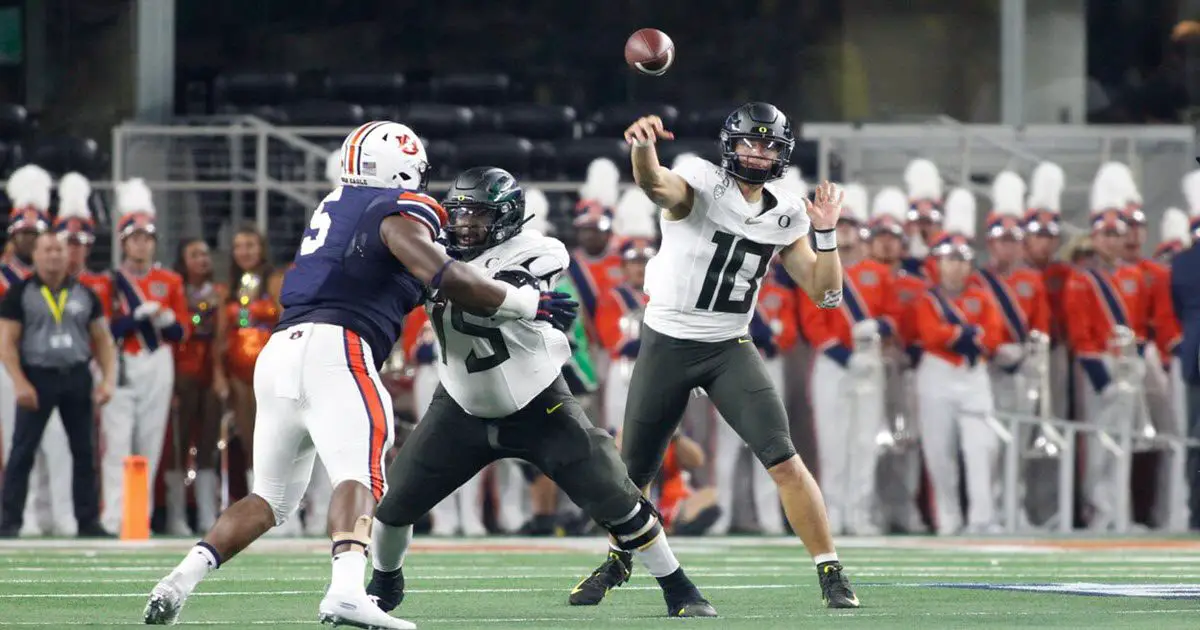You don’t have to be tuned into a televised football game long before you start to hear commentators throw around the term RPO. Most people have a basic understanding of what that is: a run-pass option. Though it’s easy enough to understand that these are plays with both the option to run or to pass, packaged together, not everyone knows when they’re seeing one unfold before them.
In this particular case, Duck offensive coordinator Marcus Arroyo has taken an Oregon fan-favorite play, the outside zone, and evolved it into something new by adding an RPO.
The classic outside zone is a play that Duck fans have been accustomed to since the arrival of Chip Kelly 11 years ago. As you can see above, it remains a part of the Oregon playbook five offensive coordinators later, and still has the power to be an effective tool, complementing a more downhill approach.

New Outside Zone RPO
Though Oregon runs the classic outside zone with an RPO attachment, we’re going to take a look at something a little different. It takes all the things that makes the classic so strong and then adds a little extra, allowing for a bit more of a complex passing option.
The blocking scheme of this version of the play (diagrammed in the video above) is very similar to the classic. In fact, the first four linemen are going to block outside zone just as before. The difference comes with the backside tackle and the tight end. The tight end will become part of the passing option with a quick out to the flat, while the tackle pass sets. The pass set does something very important that we’ll get to in a moment.
The backside linebacker is the quarterback’s key on this play. What he does dictates whether the ball is handed to the RB or is distributed within the backside passing concept.
Notice above how the backside linebacker (No. 10) in this clip stays home at the snap of the ball. This is Justin Herbert’s key that he should hand it off. He does and Travis Dye carries the ball through the B-gap for 13 yards and a first down. Had the playside defensive end (No. 3) come inside instead of outside Dye would have taken the C-gap and maybe ended up in the end zone.
There’s something else to notice in this clip. This is where the importance of the backside tackle’s pass set comes into play. Look at how the backside linebacker stays home at first, then wants to chase the run, and then hesitates again. That’s because his key for whether the play is a run or pass is Calvin Throckmorton (No. 54). Dropping into a pass set makes the LB unsure of where the ball is going and forces him to do way more thinking than playing.
Above, the backside linebacker decides to play the run. This tells Herbert to pull the ball and read that backside pass concept. In this case it’s a slant-flat concept. Bryan Addison (No. 80) runs the three yard slant, while Jacob Breeland (No. 27) runs the quick out to the flat.
This concept is used to put pressure on the corner. If he stays in front of the slant, the QB will throw to the flat. If the CB takes the flat, the QB will throw the slant. It may look as though Herbert could have picked up more yardage throwing the slant, but he’s throwing hot here, meaning that he’s throwing to where the CB blitz is coming from. Breeland gets the ball for a decent six-yard gain.
In this last example (above), you can see that Herbert is given another pass read. This play goes against the idea that you go where the CB isn’t, but Josh Delgado out does the CB physically, and Herbert has to get it to him. That ends up being a good choice, as Delgado picks up the first down on a nine-yard reception.
This new outside zone RPO is a masterful design. It doesn’t just take the classic outside zone and milk it, but it enhances it to another level. Not only does the pass set of the tackle really affect the linebacker, but the use of outside zone blocking affords the QB the time to read the pass. In contrast, inside zone may not afford enough time before linemen are too far down field.
This play is a perfect way for a team, who may not want to run their QB 15 times per game, to still incorporate option football into their offensive scheme.
Coach Eric Boles
Newark, Ohio Top Photo Credit: Melissa Macatee
 Spencer Thomas, the FishDuck.com Volunteer Editor for this article, is an attorney for the Social Security Administration in Atlanta, Georgia, and coaches High School Football for Hillgrove HS in Powder Springs, GA.
Spencer Thomas, the FishDuck.com Volunteer Editor for this article, is an attorney for the Social Security Administration in Atlanta, Georgia, and coaches High School Football for Hillgrove HS in Powder Springs, GA.
Eric resides in Central Ohio, just outside the capital city of Columbus. He is a former offensive assistant and return game coordinator for the Ohio State – Newark/Central Ohio Technical College Titans football program.
He is an OSU-N graduate, having completed a Bachelor of Arts program in psychology.

